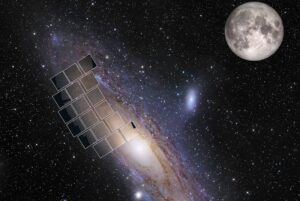Astronomers anticipate upcoming images of the Andromeda galaxy may hold vital clues

The Roman Space Telescope’s simulated view over the Andromeda galaxy. Credit: NASA, NASA-GSFC, ASU, Robert Gendler DSS
Although dark matter makes up 27% of the universe, astronomers have been unable to observe it directly.
Now, in a new study, an international team of researchers including Northwestern University astrophysicists has found that upcoming images from NASA’s Nancy Grace Roman Space Telescope (set to launch by May 2027) may hold vital clues to understanding the elusive material.
In the hunt for dark matter, some astrophysicists previously have focused on the gaps in streams of stars — areas where the structures are so thin that it’s possible to spot disturbances created by clumps of dark matter. But, so far, astronomers have only examined these gaps in the Milky Way. With the Roman Space Telescope taking images of our neighboring Andromeda galaxy, researchers will greatly expand their growing sample of thin stellar streams, potentially leading to more information about the concrete properties of dark matter.
The study has been accepted for publication by The Astrophysical Journal. A preprint currently is available online. It marks the first exploration of the prospects of finding gaps within streams of stars beyond our own Milky Way galaxy.
“There are stellar streams in our own galaxy, where we see gaps that might be due to dark matter,” said Northwestern’s Tjitske Starkenburg, who co-authored the study. “But these gaps also can be formed by other means. Our new study makes the case that we will be able to observe these gaps in nearby galaxies other than our own. That will give us better statistics on these gaps, which ultimately will help us better understand the possible existence and properties of dark matter clumps.”
Starkenburg is a research assistant professor at Northwestern’s Center for Interdisciplinary Exploration and Research in Astrophysics (CIERA). Christian Aganze, a postdoctoral fellow at Stanford University, is the study’s lead author.
Assumed to be a particle, dark matter cannot yet be observed directly because it does not emit, reflect, refract or absorb light. Because no one can see it, researchers have to look to other clues to determine if it’s actually there.
“We see dark matter’s effect on galaxies,” Aganze said. “For example, when we model how galaxies rotate, we need extra mass to explain their rotation. Dark matter may provide that missing mass.”
Astronomers are particularly hopeful that clues might be hidden within the elongated streams of stars dangling from globular clusters, tightly bound groups of dozens to millions of stars. Researchers say clumps of dark matter can punch through stellar streams to create gaps. By examining these gaps, astronomers aim to uncover signs of dark matter.
Continue to the full Northwestern news article.

